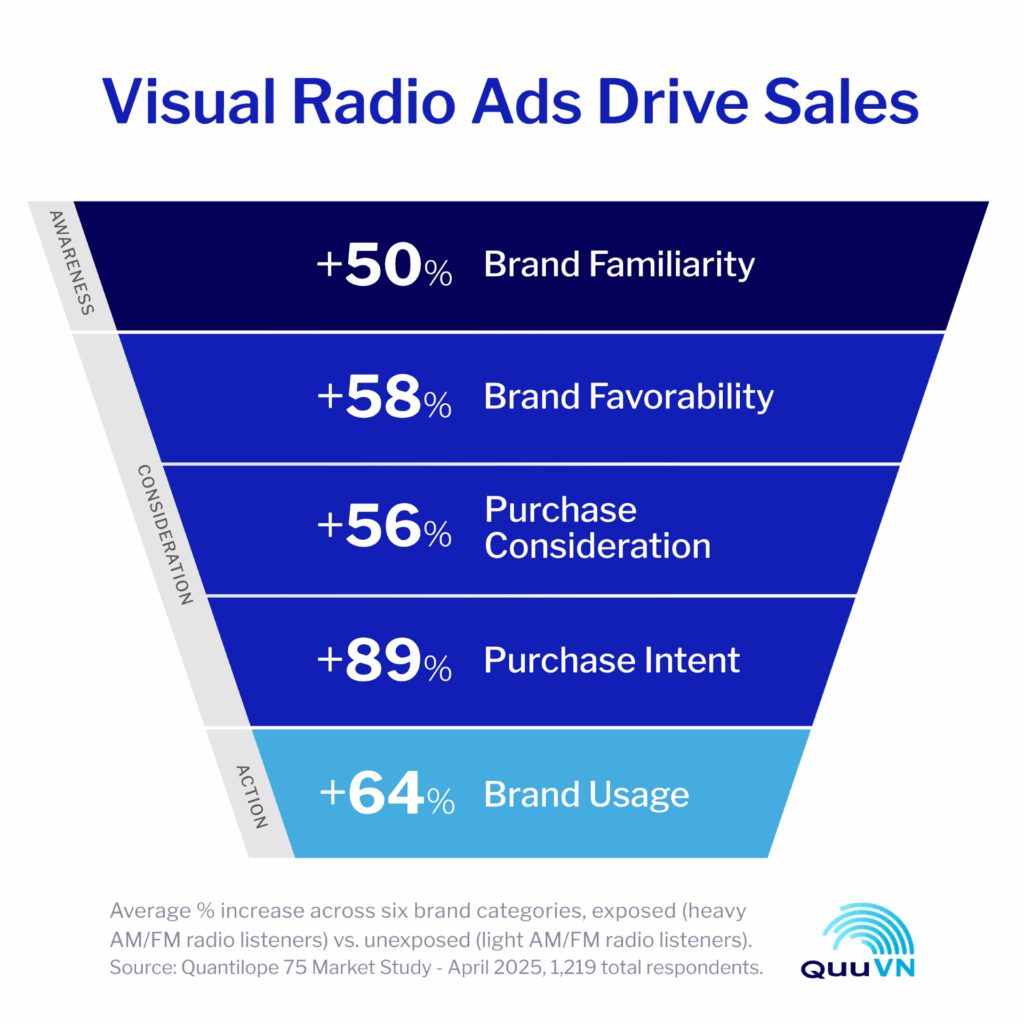Read the original article by Garrett Searight at Barrett Media »
“There’s a ton of opportunity, but we’re beginning to get our legs beneath us.”
Last week, Quu released data compiled in a study on the impacts visual ads have on radio listeners. Quu CEO Steve Newberry was impressed by the results.
The data from Quu came from a survey of more than 1,200 respondents in conjunction with Quantilope. It showcased that 89% of respondents said their purchase intent grew when advertisers utilized in-vehicle visual advertising compared to those brands that didn’t.
An additional 64% of respondents said they had made purchases and had higher viewpoints of those advertisers who utilized visual radio ads.
Furthermore, 58% said they viewed brands that used visual ads more favorably than those that didn’t, and 56% said their purchase consideration was altered by visual radio advertisers.
When asked where he thought visual ads for radio was in its life cycle, Steve Newberry had a quick answer.
“I think we’re in the sunrise,” he shared. “I don’t want to say the beginning, but we’re probably now moved past the toddler stage. There’s so much more that we’re going to be able to do. But there’s a ton of opportunity. We’re beginning to get our legs beneath us.

“I don’t want to pretend that this is the end-all research, to end all things that will ever happen on planet Earth. This is a contribution to the conversation,” Newberry continued. “But it’s legitimate research from a third party, and it certainly has caused a lot of conversation. I think we’re very much in the early stages. I think that it’s not a newborn anymore. It’s not a toddler. We’ve got our legs under us, but we’ve got a lot of opportunity to grow even more in the life cycle.”
The Quu CEO stated that he was “overwhelmed by how positive the results were” and impressed by how much visual ads impressed upon radio listeners.
“Radio has long been known for its ability to develop a brand (and) brand awareness,” Newberry said. “But we saw that we had full funnel impact, not just top of the funnel, but in terms of all the positives as you move through, including purchasing intent. It showed the real power of what radio stations and visuals to the messages can do.”
The data is also likely to be an important message for both advertisers and broadcasters about the power that adding a visual component to an already familiar radio ad can be.
“I think it’s hugely important, because in today’s world, that has more digital competition for radio broadcasters, lots of times, I think the digital technology gets an overabundance of credit for what radio delivers. Listen, I’m a strong believer that the combination of radio and digital is a powerful tool for advertisers, but I want radio to get its fair share plus,” said Newberry.
“When you see that those numbers just get stronger as you go down through the funnel, it’s really amazing. Increasing the purchase intent of a product by 89%? That’s a dramatic number.”
The Quu CEO added that he believes that the data highlights the power that AM/FM radio still possesses with wide swaths of audiences and has an ability to leverage that familiarity with the audience into a medium that drives results for advertisers.
“One of the things we wanted to test, which is, does it get a plateau? Does it cause fatigue? The more people see the display — the more loyal audiences — do you see a diminishing number? And, in fact, it is the opposite of that. You see the numbers get stronger and stronger.
“So if I’m listening to my favorite rock station and I see a message on my favorite rock station, that endorsement appears, but the endorsement of the station, displaying that message adds even more power to it. We’ve known that for years: people feel strongly about their radio station,” Newberry continued. “They feel emotionally connected to their radio station. And I believe this research conveys to the advertisers when they’re seeing their visual message on the screen, reinforcing who is advertising on the station or supporting the station, or has that same sense of value, sense of purpose, sense of entertainment that the radio station offers.”
Quu CEO Steve Newberry was asked what the action item should be for radio broadcasters and station ownership groups after the data was so overwhelmingly positive.
He said that the industry needs to sing its praises to everyone who will listen.
“Radio still has a visual component that is valuable, meaningful, and impactful to their advertising clients,” said Newberry. “There’s a way to reinforce the message. There’s a way to tap into the loyal radio audiences. I’m a huge radio advocate, as everybody knows, but radio’s long been a great way to emotionally connect with advertisers and the listeners and to build that brand awareness.
“But now we see how much it builds the loyalty and the intent of those consumers. So if I’m a radio station operator, the first thing I want to do is make sure that I’m taking advantage of the technology to deploy the visual side. But the other thing that I’m doing is taking this information, getting in front of my advertisers and saying, ‘Don’t miss this very efficient, very smart way to increase the impact of your brands on radio and really drive the consumer’s positive impact and positive perception of what those products are.’”
__________

